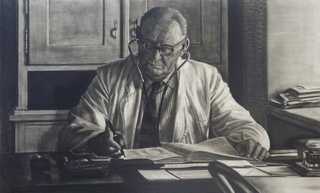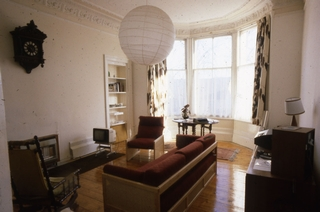Last night, a friend and I made the effort to trawl out to Manchester to Castlefield Gallery to see David Gledhill and Corin Swornin conversation. Both artists use found snapshot photographs in their work. It was fascinating hearing how they had reconstructed a narrative based on images which had been discarded. David had come across a photo album that had been found in a flea market, and Corin had found a skip full of slides.
 From the photograph album, which Doctor Munscheid had presented to his daughter on the occasion of her wedding, David Gledhill created a series of paintings in soft sepia hues. He aimed to recreate the ‘idealism’ that he saw in the photographs which were taken in East Germany between 1951 and 1962. In them he saw a family surviving a regime change by carrying on (or appearing to carry on) as normal. I reflected that this is a feature typical of family snapshots – they ignore the socio/political and industrial context. There was some discussion about how snapshots are carefully framed and posed performances, and how the photographer wanted to portray an idealised family. Yet there were uncanny aspects in the images. One showed the Doctor sitting at his desk writing, his stethoscope indicating his profession. And yet the stethoscope was in his ears. Why? Something that struck me in David’s talk was his keen interest in the subjects of his paintings. As he said, he liked to paint subjects that he is fascinated by. He had done a lot of research into the time, place, and politics of the community represented. It brought home the fact that by painting snapshots, you also draw attention to the context in which they were taken.
From the photograph album, which Doctor Munscheid had presented to his daughter on the occasion of her wedding, David Gledhill created a series of paintings in soft sepia hues. He aimed to recreate the ‘idealism’ that he saw in the photographs which were taken in East Germany between 1951 and 1962. In them he saw a family surviving a regime change by carrying on (or appearing to carry on) as normal. I reflected that this is a feature typical of family snapshots – they ignore the socio/political and industrial context. There was some discussion about how snapshots are carefully framed and posed performances, and how the photographer wanted to portray an idealised family. Yet there were uncanny aspects in the images. One showed the Doctor sitting at his desk writing, his stethoscope indicating his profession. And yet the stethoscope was in his ears. Why? Something that struck me in David’s talk was his keen interest in the subjects of his paintings. As he said, he liked to paint subjects that he is fascinated by. He had done a lot of research into the time, place, and politics of the community represented. It brought home the fact that by painting snapshots, you also draw attention to the context in which they were taken.
 Corin Sworn created an installation of slide projectors displaying a selection of the slides she’d found. There was a small red diary with notes and ‘to-do’ lists. A vase of flowers in one corner had a slide projector pointed towards it, casting a shadow of the flowers onto the wall. For me, this raised questions of signifier and signified, and also referenced the myth of the birth of painting, where a girl traced the profile of her lover from his shadowed profile on the wall. There was a tape cassette player playing a commentary read out by the artist from a set of notes that were also available to read. Some of the written notes had been crossed out, and were not included in the audio commentary but we could still read them. Corin was interested in the slides as images of the past. She was interested in how they conjure up nostalgia, and its function socially. While she had created a loose narrative, she wasn’t looking for an ‘objective’ position or doing research. She was thinking about the viewer, and how they might try to make sense of the works. She chose to use different subjective viewpoints, many of which she selected from texts including theory and poetry. She was tapping into the history of bringing text into the gallery, and the way that removed the need for an object as art. For her, the word itself has a materiality in its tone and texture. I experienced her piece in a fragmented and dream-like way. Words from the spoken commentary drifted into my consciousness as I was looking at the images. You can’t view both projections at once, so viewing them is a fragmented experience. I tried to construct my own narrative, piecing things together from the diary, the images and the commentary. But I couldn’t make it make sense; coherence evaded me. I liked that.
Corin Sworn created an installation of slide projectors displaying a selection of the slides she’d found. There was a small red diary with notes and ‘to-do’ lists. A vase of flowers in one corner had a slide projector pointed towards it, casting a shadow of the flowers onto the wall. For me, this raised questions of signifier and signified, and also referenced the myth of the birth of painting, where a girl traced the profile of her lover from his shadowed profile on the wall. There was a tape cassette player playing a commentary read out by the artist from a set of notes that were also available to read. Some of the written notes had been crossed out, and were not included in the audio commentary but we could still read them. Corin was interested in the slides as images of the past. She was interested in how they conjure up nostalgia, and its function socially. While she had created a loose narrative, she wasn’t looking for an ‘objective’ position or doing research. She was thinking about the viewer, and how they might try to make sense of the works. She chose to use different subjective viewpoints, many of which she selected from texts including theory and poetry. She was tapping into the history of bringing text into the gallery, and the way that removed the need for an object as art. For her, the word itself has a materiality in its tone and texture. I experienced her piece in a fragmented and dream-like way. Words from the spoken commentary drifted into my consciousness as I was looking at the images. You can’t view both projections at once, so viewing them is a fragmented experience. I tried to construct my own narrative, piecing things together from the diary, the images and the commentary. But I couldn’t make it make sense; coherence evaded me. I liked that.
With both artists, I was interested in why they chose to take discarded images and reconstruct something from them. I was interested in the human impulse which their work represents which makes us feel that such personal images which have been simply chucked away have an almost unbearable poignancy. That impulse to rescue them, lavish attention on them and reconstruct some sort of narrative (however fragmented) took me back to something Roland Barthes said about photography being an attempt to cheat death. Perhaps if we can bring these lives back to life in some way, then our own lives with all their richness and complexity won’t simply vanish and become meaningless once we die. How many of us can really bear the idea that when the lights go out for the last time, all the things we value, strive for and care about become someone else’s problem to be chucked in a skip?